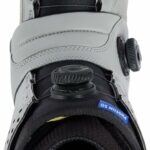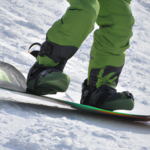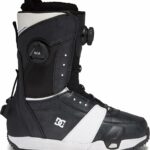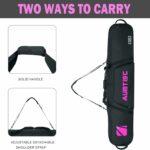So you’re thinking about hitting the slopes with a new snowboard, huh? The thrill of speeding down a powdery mountain is hard to beat, but it’s essential to have the right gear with you. Choosing the perfect snowboard might seem like a daunting task, what with all the different options available. This article breaks down the process into digestible chunks. By the end of it, you’ll know exactly how to select the best board for your shredding adventures.
Understanding the Types of Snowboards
Before you step foot on the snowy slopes, you need to understand the different types of snowboards. Given the variety available today, finding the right one for your specific needs might seem a bit daunting. However, once you get know the details, you’ll find it’s not so complicated. They come in five main types- all-mountain, freestyle, freeride, powder boards, and splitboards.
All-Mountain Snowboards
An all-mountain snowboard is a jack-of-all-trades. It’s equally at home on groomed pistes, powder, parks, or pipes. These boards are designed to perform in all types of snow conditions and terrain. They can dwindle between on and off-piste, between groomed runs, powder or slush.
Freestyle Snowboards
Freestyle snowboards are for those who live for the park. Shorter in size and centred in stance, freestyle snowboards are perfect for tricks, jumps, rails, boxes and half pipes. They are lightweight and have a soft to medium flex.
Freeride Snowboards
Free spirits with a hunger for off-piste and backcountry terrain might opt for freeride snowboards. They’re typically longer for stability and have a directional shape, which means they are intended to ride in one direction.
Powder Boards
Just as the name suggests, powder boards are designed especially for deep snow. With a wider nose and narrower tail, these boards help to keep you atop the deepest of snow. They provide the surf-like feel powder-hounds crave.
Splitboards
Setting off into the backcountry? Splitboards could be your best companions. They can be separated into two skis for uphill ascents and joined together to become a snowboard for downhill runs.
Choosing the Right Snowboard Size
Once you understand the board types, the next step in choosing a snowboard is deciding on the appropriate size. Factors including your weight, height, and the board’s length and width all play key roles in determining the right snowboard size for you.
Considering Your Weight
When choosing a snowboard, you should base its length on your weight rather than your height. That’s because your weight creates downward pressure when boarding, and it’s that pressure you’ll be using to turn the board.
Analyzing Your Height
While weight holds more importance, height can still have an impact in board selection. A board should reach somewhere between your shoulder and chin when stood on end.
Understanding Snowboard Length
The length of the snowboard can impact your riding style. A shorter board is easier to maneuver and preferred by freestylers, while a longer board provides better stability at high speeds and is a favorite for free-riders and powder hounds.
Knowing Snowboard Width
The width of a snowboard is key to preventing toe and heel drag, which can cause a rider to fall. A rider’s boot size dictates board width – a wider board for larger feet, and narrower for smaller ones.
Board Flexibility and Its Importance
Flexibility refers to the amount of flexibility a snowboard has from nose to tail. Far from being a matter of preference, the flexibility of a snowboard can significantly impact performance on different types of terrain.
Soft Flex
Soft flex boards are more manoeuvrable at low speeds and are great for tricks. They’re also more forgiving and could be a good choice for beginners.
Medium Flex
Boards with medium flex are all-rounders. They’re versatile and can handle all kinds of terrain. They’re popular among those who enjoy all-mountain riding.
Stiff Flex
Stiff flex boards are the answer for high-speed stability, crucial when zooming down steep terrain. They respond quickly and are excellent at carving deep turns.
Factors Affecting Flexibility Preferences
Flex preferences can vary on account of riding style, speed, terrain, and even the weight of the rider. For instance, a lighter rider may prefer a softer board, whereas a heavier rider might require a stiffer board for the same conditions.
Types of Snowboard Profiles
Snowboard profiles determine the board’s curve patterns from tail to nose, which impact its performance. Boards come in four main profiles: camber, rocker, flat, and hybrid.
Camber
Camber boards curve upwards in the middle and touch near the nose and tail when unweighted. They offer superior edge hold and powerful turns which makes them a popular choice among advanced and aggressive riders.
Rocker
Rocker boards are the exact opposite, curving upward at the middle and touching down at the tip and tail. This allows for excellent maneuverability and float in powder, however, they can be unstable at high speeds.
Flat
Flat boards deliver a balanced feel, providing a middle ground between camber and rocker. They offer decent stability and edge hold, making them suitable for beginners and intermediate riders.
Hybrid
Hybrid boards blend the elements of the other profiles, offering a versatile ride that adapts to varying conditions and styles. Their features depend on how the elements are mixed, offering something for beginners to experts.
Choosing the Right Snowboard Shape
A snowboard’s shape will also affect its performance. Boards come in three main shapes- directional, twin, and directional twin.
Directional Shape
Directional boards are designed to be ridden in one direction. They’re typically stiffer in the tail and softer at the nose, providing stability at speed and float in powder. They’re loved by free-riders and powder riders.
Twin Shape
Twin-shaped boards are symmetrical with identical nose and tails, and the inserts are centered. The symmetrical shape makes for easy switch riding, making them perfect for park riders and freestyle maniacs.
Directional Twin Shape
Directional twin shaped boards are a fusion of the two previous shapes. They have a symmetrical shape but different flexes from nose to tail. They’re versatile and popular among the all-mountain crowd.
Understanding Snowboard Construction
The construction of your snowboard will play a significant role in how it performs on the slopes. Four key components come together to create a snowboard: the core, the base, the edges, and the sidewalls.
The Core
The core is the heart of the snowboard, often made of wood or foam. The material and design of the core affect the board’s weight, strength, flexibility, and responsiveness.
The Base
The base of the snowboard is the part that comes in contact with the snow. Made from P-Tex (a type of durable plastic), bases come in two types: extruded and sintered. Extruded bases are low maintenance but slower, while sintered bases are faster but require more care.
The Edges
Edges are the steel strips along the sides of the board. They bite into the snow during turns. Some boards come with a full-wrap edge while others have partial edges. The type of edge has an impact on the durability and performance of the snowboard.
The Sidewalls
Sidewalls run the full length of the snowboard between the top and base. They help to strengthen the board, absorb shocks, and bear the load of the rider’s weight and turning forces.
The Right Snowboard for Your Riding Style
Snowboarding styles can be roughly categorized into all-mountain, freestyle, backcountry, and carving. The right snowboard for you will largely depend on your preferred style.
All-Mountain Riding
Majority of riders are all-mountain riders who enjoy cruising on all sorts of terrains, be it groomed slopes or off-piste terrains. An all-mountain board is usually the best companion for these riders.
Freestyle or Park Riding
Freestyle or park riders spend most of their time in the terrain park doing tricks and jumps. A shorter, softer flex board will be best-suited to their needs.
Backcountry Riding
Backcountry riders seek unmarked and unpatrolled areas, often in pursuit of fresh powder. Freeride or powder boards, possibly with a splitboard design, would be the ideal match here.
Carving or Race Riding
This riding style is all about making big carving turns on hardpack snow. Carving boards are often stiffer and have a deeper sidecut for responsive turning.
Deciding on the Right Bindings
Bindings are an essential piece of your snowboarding setup. They connect you to your snowboard, allowing you to steer it. Three main factors come into play in binding selection: flex, baseplates, highbacks, and straps.
Binding Flex
Similar to boards, bindings come with a flex rating and should be matched with your boot flex and riding style. Softer flex is good for freestyle, medium for all-mountain, and stiff for free-riding.
Binding Baseplates
The baseplate is the area of the binding that comes in direct contact with the board. Different materials can affect the way the board flexes and responds.
Highbacks
The highbacks part of the bindings is responsible for control during heel edge turns. Highbacks vary in height and stiffness, affecting responsiveness and overall ride comfort.
Straps
Straps hold your boots in the bindings. The key things to look for in straps are their ease of use and the comfort they offer. Most come with tool-free adjustments, making them easy to adjust on the fly.
Choosing the Appropriate Snowboard Boots
Snowboard boots are a crucial piece of equipment. It’s important to find a pair that fits right and matches your riding style. Boot flex and the lacing system are two key elements to consider in boot selection.
Understanding Boot Flex
Like snowboards and bindings, boots also come with a flex rating. Softer-flexing boots are great for freestyle riding while stiffer boots are designed for free-riding and backcountry.
Considering Boot Fit
Comfort is king when choosing your snowboard boots. They should fit snugly around all parts of your foot, with no obvious pressure points or empty spaces.
Looking at Lacing Systems
Lacing systems might seem trivial, but actually have a big impact on comfort and performance. Quick-pull laces and Boa systems are designed for convenience, while traditional laces offer the most customization as you can adjust the tightness anywhere along the boot.
Taking Your Budget into Consideration
Finally, your budget plays an important role in your choice of snowboard. Remember, a higher price doesn’t necessarily guarantee a better ride. Maintenance, the possibility of used equipment and knowing where to buy can also save you significant amounts.
Analyzing Cost and Quality
As with most things, with snowboards, you often get what you pay for. However, assume the most expensive board won’t automatically be the best for you. Define your needs well before choosing a board within your budget.
Considering Used Equipment
Used does not always mean abused, and you can often find quality used snowboarding equipment. Buying used can be a great way to save some money, especially for beginners.
Knowing Where to Buy
Specialist snowboard shops and online retailers are the usual places to buy. Both can offer good deals, but remember online may restrict you from getting a real feel for the board before you buy.
Understanding the Importance of Maintenance and Upkeep
Finally, while shopping, consider the upkeeping costs. Regular waxing, edge tuning, and possible repairs can add up over time. But keeping your board well maintained will extend its lifetime and ensure the best performance on the slopes.
In conclusion, there are a bunch of factors you’ll want to consider while choosing your snowboard, from its type and size, through its flex and shape, to its construction. Considering your own skill level, style of riding, as well as budget, is equally important. It might seem like a lot to take into account, but ultimately, understanding these aspects will allow you to choose a board that offers you the most fun on the slopes. Now, it’s time for you to hit the shops and find that perfect snowboard! Happy riding!
- What Snowboard Bindings Should I Get? - January 23, 2024
- What Size Screws For Snowboard Bindings? - January 23, 2024
- How To Snowmobile On Water? - January 23, 2024










